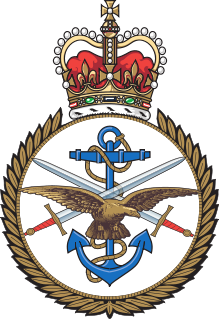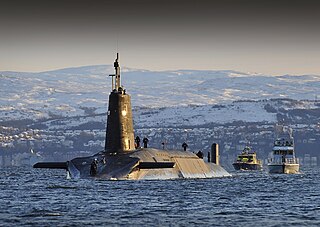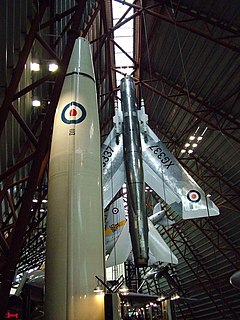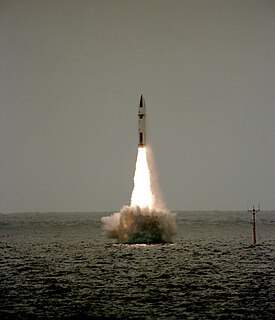
The Avro Blue Steel was a British air-launched, rocket-propelled nuclear armed standoff missile, built to arm the V bomber force. It allowed the bomber to launch the missile against its target while still outside the range of surface-to-air missiles (SAMs). The missile proceeded to the target at speeds up to Mach 3, and would trigger within 100 m of the pre-defined target point.

The Polaris Sales Agreement was a treaty between the United States and the United Kingdom which began the UK Polaris programme. The agreement was signed on 6 April 1963. It formally arranged the terms and conditions under which the Polaris missile system was provided to the United Kingdom.

The British Armed Forces, also known as Her Majesty's Armed Forces, are the military services responsible for the defence of the United Kingdom, its overseas territories and the Crown dependencies. They also promote the UK's wider interests, support international peacekeeping efforts and provide humanitarian aid.

The "V bombers" were the Royal Air Force (RAF) aircraft during the 1950s and 1960s that comprised the United Kingdom's strategic nuclear strike force known officially as the V force or Bomber Command Main Force. The three models of strategic bomber, known collectively as the V class, were the Vickers Valiant, which first flew in 1951 and entered service in 1955; the Avro Vulcan, which first flew in 1952 and entered service in 1956; and the Handley Page Victor, which first flew in 1952 and entered service in 1957. The V Bomber force reached its peak in June 1964 with 50 Valiants, 70 Vulcans and 39 Victors in service.

The Vanguard class is a class of nuclear-powered ballistic missile submarines (SSBNs) in service with the Royal Navy. The class was introduced in 1994 as part of the Trident nuclear programme, and comprises four vessels: Vanguard, Victorious, Vigilant and Vengeance, built between 1986 and 1999 at Barrow-in-Furness by Vickers Shipbuilding and Engineering, now owned by BAE Systems. All four boats are based at HM Naval Base Clyde , 40 km (25 mi) west of Glasgow, Scotland.

The Ministry of Defence is the British government department responsible for implementing the defence policy set by Her Majesty's Government, and is the headquarters of the British Armed Forces.

The British Aircraft Corporation TSR-2 is a cancelled Cold War strike and reconnaissance aircraft developed by the British Aircraft Corporation (BAC), for the Royal Air Force (RAF) in the late 1950s and early 1960s. The TSR-2 was designed around both conventional and nuclear weapons delivery: it was to penetrate a well-defended frontline areas at low altitudes and very high speeds, and then attack high-value targets in rear areas. Another intended combat role was to provide high-altitude, high-speed stand-off, side-looking radar and photographic imagery and signals intelligence, aerial reconnaissance. Only one airframe flew and test flights and weight-rise during design indicated that the aircraft would be unable to meet its original stringent design specifications. The design specifications were reduced as the result of flight testing.

The Atomic Weapons Establishment (AWE) is a United Kingdom Ministry of Defence research facility responsible for the design, manufacture and support of warheads for the UK's nuclear weapons. It is the successor to the Atomic Weapons Research Establishment (AWRE) with its main site on the former RAF Aldermaston and has major facilities at Burghfield, Blacknest and RNAD Coulport.

The WE.177, originally styled as WE 177, and sometimes simply as WE177, was a series of tactical and strategic nuclear weapons with which the Royal Navy (RN) and the Royal Air Force (RAF) were equipped. It was the primary air-dropped nuclear weapon in the United Kingdom from the late 1960s into the 1990s.

The Nassau Agreement, concluded on 21 December 1962, was an agreement negotiated between President of the United States, John F. Kennedy, and Harold Macmillan, the Prime Minister of the United Kingdom, to end the Skybolt Crisis. A series of meetings between the two leaders over three days in the Bahamas followed Kennedy's announcement of his intention to cancel the Skybolt air-launched ballistic missile project. The US agreed to supply the UK with Polaris submarine-launched ballistic missiles for the UK Polaris programme.
The Ministry of Supply (MoS) was a department of the UK government formed in 1939 to co-ordinate the supply of equipment to all three British armed forces, headed by the Minister of Supply. A separate ministry, however, was responsible for aircraft production, and the Admiralty retained responsibilities for supplying the Royal Navy. During the war years the MoS was based at Shell Mex House in The Strand, London.

In 1952, the United Kingdom became the third country to develop and test nuclear weapons, and is one of the five nuclear-weapon states under the Treaty on the Non-Proliferation of Nuclear Weapons.

The 1958 US–UK Mutual Defense Agreement, or UK–US Mutual Defence Agreement, is a bilateral treaty between the United States and the United Kingdom on nuclear weapons co-operation. The treaty's full name is Agreement between the Government of the United States of America and the Government of the United Kingdom of Great Britain and Northern Ireland for Cooperation on the uses of Atomic Energy for Mutual Defense Purposes. It allows the US and the UK to exchange nuclear materials, technology and information. The US has nuclear co-operation agreements with other countries, including France and other NATO countries, but this agreement is by far the most comprehensive. Because of the agreement's strategic value to Britain, Harold Macmillan called it "the Great Prize".

Trident, also known as the Trident nuclear programme or Trident nuclear deterrent, covers the development, procurement and operation of nuclear weapons in the United Kingdom and their means of delivery. Its purpose as stated by the Ministry of Defence is to "deter the most extreme threats to our national security and way of life, which cannot be done by other means". Trident is an operational system of four Vanguard-class submarines armed with Trident II D-5 ballistic missiles, able to deliver thermonuclear warheads from multiple independently targetable re-entry vehicles (MIRVs). It is operated by the Royal Navy and based at Clyde Naval Base on the west coast of Scotland. At least one submarine is always on patrol to provide a continuous at-sea capability. Each one carries no more than eight missiles and forty warheads, although their capacity is higher. The missiles are manufactured in the United States, while the warheads are British.
An Operational Requirement, commonly abbreviated OR, was a United Kingdom (UK) Air Ministry document setting out the required characteristics for a future military aircraft or weapon system.

Project E was a joint project between the United States and the United Kingdom during the Cold War to provide nuclear weapons to the Royal Air Force (RAF) until sufficient British nuclear weapons became available. It was subsequently expanded to provide similar arrangements for the British Army of the Rhine. A maritime version of Project E known as Project N provided nuclear depth bombs used by the RAF Coastal Command.

Project Emily was the deployment of American-built Thor intermediate-range ballistic missiles (IRBMs) in the United Kingdom between 1959 and 1963. Royal Air Force (RAF) Bomber Command operated 60 Thor missiles, dispersed to 20 RAF air stations, as part of the British nuclear deterrent.

The Ministry of Defence Police (MDP) is a civilian special police force which is part of the United Kingdom's Ministry of Defence. The MDP's primary responsibilities are to provide armed security and counter terrorism services to designated high-risk areas, as well as uniformed policing and limited investigative services to Ministry of Defence property, personnel, and installations throughout the United Kingdom. The MDP are not military police and should not be confused with the Royal Military Police or any other British Service Police. Service personnel often refer to the MDP by the nickname "MOD plod".

The United Kingdom's Polaris programme, officially named the British Naval Ballistic Missile System, provided its first submarine-based nuclear weapons system. Polaris was in service from 1968 to 1996.
Red Hebe was a large active radar homing air-to-air missile developed by Vickers for the Royal Air Force's Operational Requirement F.155 interceptor aircraft. It was a development of the earlier Red Dean, which was not suitable for launch by the new supersonic aircraft. Before progressing much beyond advanced design studies, F.155 was cancelled in the aftermath of the 1957 Defence White Paper which moved Britain's attention from strategic bombers to ballistic missiles. With no other suitable platform, Red Hebe was cancelled as well.

















